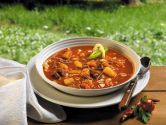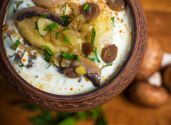Travel With a Spoon Around Ukraine: 14 Unconventional Dishes Worth Tasting
Ukrainian cuisine reflects the character of its people: rich and generous. Our receipts have been forming and changing for a long time. Some of the dished have become so beloved among Ukrainians, so now they are considered as original traditional Ukrainian meals, in spite the fact they are of another origin. Let’s take a deeper discussion of certain delicacies that can be met on our lands.
Flyaky (Flyachky)
A plain dish named as Flyachky belongs to Polish cuisine. But it was widely spread among the people of Galicia.
Flyaky is just a soup with the main ingredient of beef tripe. The recipe is quite simple and all the ingredients could be found in the nearest store. Due to its bright taste and a huge amount of energy given by the soup it had become a beloved dish among the local people. You’ll be surprised how much force you can get by eating this simple and flavored broth.
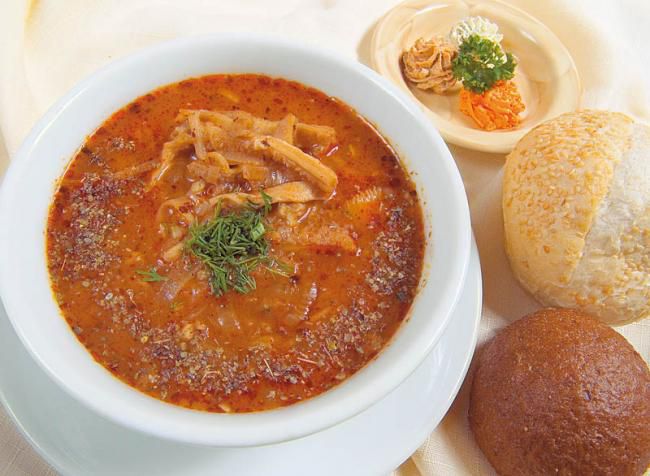 Photo source: all-pages.com.
Photo source: all-pages.com.
Where to taste: Flyaky is a specialty at “Hostinny Pan” restaurant in Vinnitsia (3A, General Arabey Street).
Price: the average price for the dish is 35 UAH.
Banush
Banush is a traditional course of Galicia cuisine, which is a strong porridge of cornmeal cooked on milk or sour cream. It is also called as perpetual motion, as even a small portion of it is enough to feed all the members of a large village family.
They say the recipe of Banush was invented when there was nothing to eat at all and everything left were sour cream and some corn flour. According to the tradition the porridge should be cooked by men only and only over the fire, being stirred slowly with a wooden spoon.
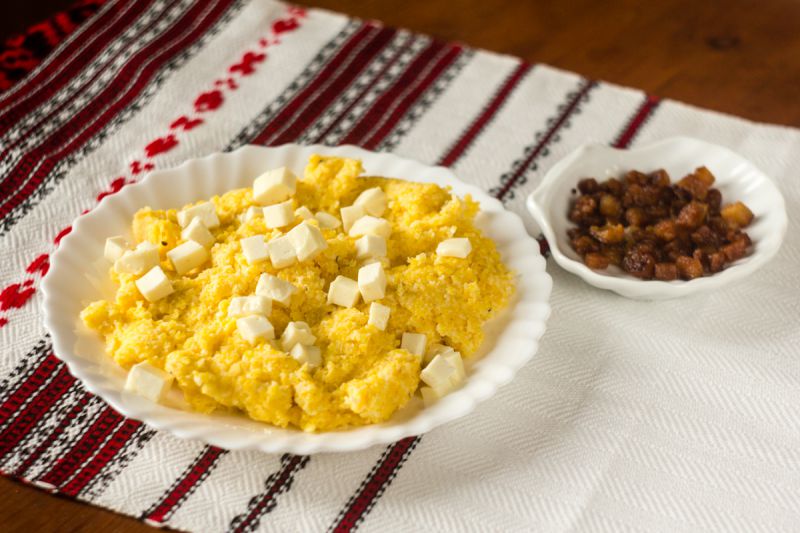 Photo source: g.io.ua.
Photo source: g.io.ua.
Where to taste: You can taste it in lots of cafes and restaurants of Carpathian region. For example you can visit “Filvarok” inn at Bukovel ski resort, which is situated on the top of the Lift #2.
Price: a plate od Banush costs 29 UAH plus 12 UAH for complements.
Knysh
There are a lot of argues about the origin of Knysh, but most people are sure it belongs to Belarus cuisine. Round buns of puff pastry and a lot of different fillings gained a huge popularity among the people of many nations. No wonder a lot of them try to assign the invention of the original recipe of the dish.
Knysh is usually served as a compliment to hot meet dishes. The filling can be different. The most widespread one is Knysh with buckwheat, onion and greaves. The fillings can also be sweet: with jam, cottage cheese or berries. In Ukrainian cuisine the most popular are Knysh with white cheese, mushed potatoes, cheese or cabbage.
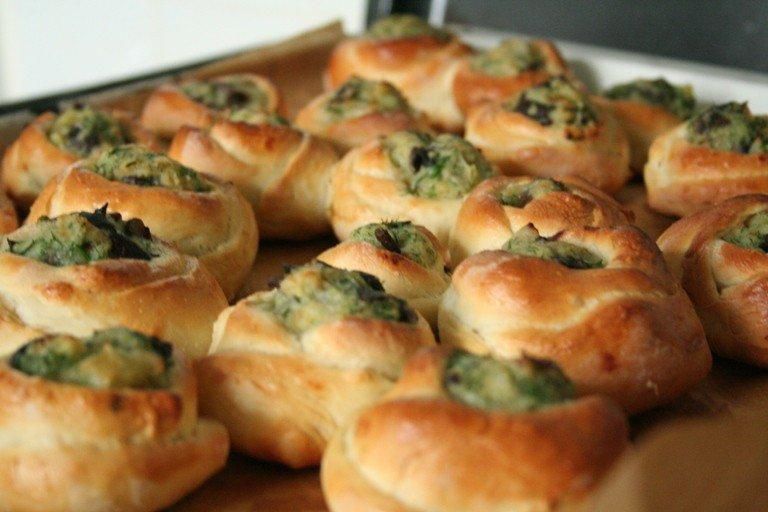 Photo source: miranda-kitchen.livejournal.com.
Photo source: miranda-kitchen.livejournal.com.
Where to taste: in Ukraine such kind of dish is popular in Polesia region. A plenty of restaurants in Volyn, Rivne, Zhytomyr, Kyiv, Chernihiv and Sumy regions offer this course to their guests.
Price: in average – 20 UAH.
Sbiten
Sbiten is an ancient Slavic drink being famous and used to be the most beloved one in times long before tea appeared in Rus’. This drink is not less a thousand years old and first samovars were particularly made for boiling Sbiten and later got the mission casual for us.
Sbiten is made on the base of honey with addition of species and herbals. The drink is considered t be full of vitamins. It provides tonic and therapeutic effect and can be helpful in lots of different illnesses. It can be both alcohol and soft and it can be drunk hot or cold.
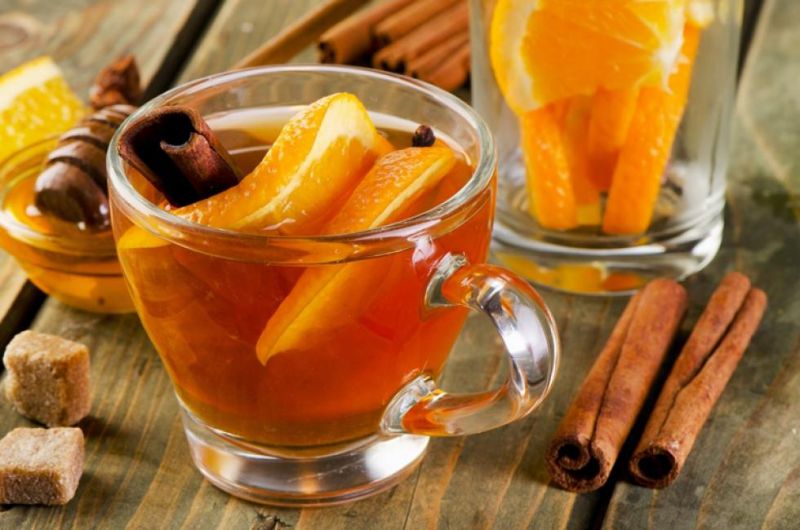 Photo source: wclub.ru.
Photo source: wclub.ru.
Where to taste: “Fat Lion” Pub, 18, Bolshaya Vasilkovskaya Street, Kyiv.
Price: 0,5 l – 35 UAH.
Mezhyvo
Mezhyvo is one of originally Ukrainian dishes. This appetizer is good both hot and cold. This is something average between stewed eggplant and ragout. The common number of vegetables for this course is: beetroot, zucchini, pumpkin and tomatoes required to be accompanied with onion and carrot.
Eggplant Mezhyvo is mostly widespread in Ukraine. The thing is that within two days the dish tastes even better, as the vegetables go through additional marinate process. One can also face some fruit recipes of this course.
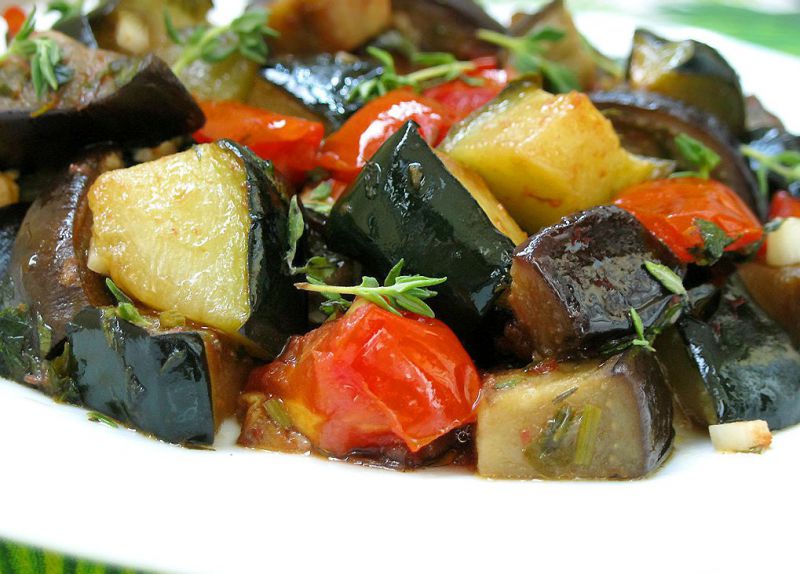 Photo source: gotovim-doma.ru.
Photo source: gotovim-doma.ru.
Where to taste: this dish is served in a plenty of restaurants in any corner of Ukraine.
Price: a plate is from 40 to 50 UAH.
Bograch (Goulash)
Hungarian word “Bograch” can be interpreted as a cooper pot. So, as well as this tableware the course has been travelled from one traditional cuisine to another. In Ukraine a popular Hungarian Goulash can be met in Trascarpathian region, where there are a lot of originally Hungarian settlements, which keep ancient traditions with great honor. To make Bograch especially distinguished you shoul cooked it in the way our ancestors did it: in a cooper pot over the fire.
There is an interesting language about how paprika became an essential ingredient of the course. Turkish which had been fighting with Hungary for a very long time once cooked their meal and put too much paprika into it. The spice was so unpleasant to their taste that they found the course disgusting and decided to give it to captive Hungarian. Since then Hungarian cuisine is rich in spicy and hot meals, which was so unlikely for their enemies.
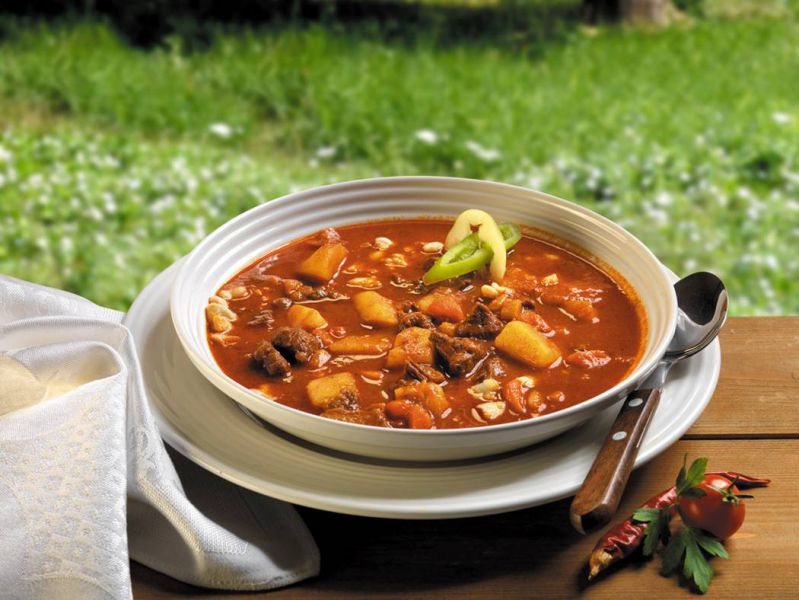 Photo source: hillsidetour.com.
Photo source: hillsidetour.com.
Where to taste: “Bograch” restaurant, 10/12 Mira Street, Mukachevo.
Price: 40 UAH in avarage.
Cholent (tsholnt or tshoolnt)
Cholent is a traditional Jewish meat course with beans, groats and vegetables. It is cooked in a clay pot in a stove (furnace). Inventive Carpathians borrowed the recipe of the dish from Jewish and turned it into casual meal for every family, not missing a chance to make some changes in it. So, Ukrainians use any kind of meat and often add paprika. They say the tastiest Cholet is made of smoked ham or bacon, you may also add garlic for additional zest.
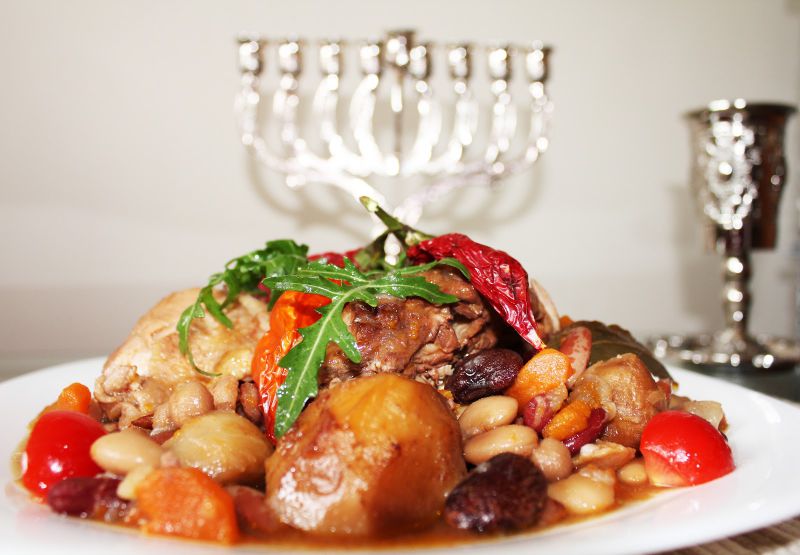 Photo source: zapas-slov.com.ua.
Photo source: zapas-slov.com.ua.
Where to taste: “Kiflyk” café, 4, Shota Rustavely Street, Kyiv.
Price: the plate costs 75 UAH.
Rakott Krumpli
Rakott Krumpli is one more course borrowed from Hungarians. It’s common knowledge that Hungarian cuisine is rich in vegetable casseroles of different type. But this recipe is extremely easy and will hardly be left with someone’s attention.
From the language of Hungarian ancestors «Rakott Krumpli» means “potato baked in layers”. To cook this course you’ll need the ingredients which could be found at any house: potatoe, eggs, cheese, smoked sausage and paprika, of course.
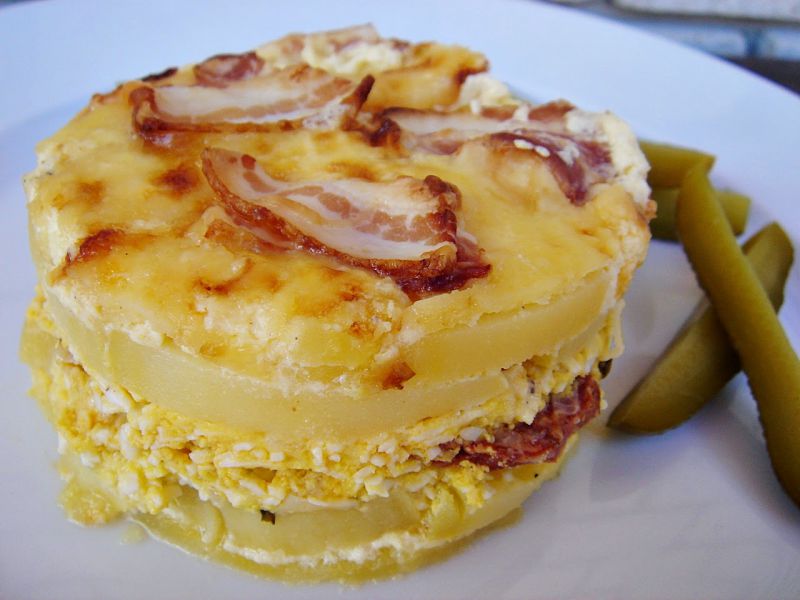 Photo source: nemvagyokmesterszakacs.blogspot.com.
Photo source: nemvagyokmesterszakacs.blogspot.com.
Where to taste: this course can be tasted at lots of cafes and restaurants in Western Ukraine.
Price: around 40 UAH.
Tokan
Originally Tokan came from Romanian cuisine but it wasn’t an obstacle to let the dish become a beloved one among Ukrainians. It is often compared with Mamalyha, but there’s a difference between them. Mamalyha is a porridge made out of yellow maize flour and Tokan is a meat course served with porridge of such kind.
During hundreds of years the recipe has changed a lot and now Tokan is served in the following way: first, a layer of porridge is put on a plate, than goes a layer of white cheese and a layer of porridge again. There can be more than three layers, as much as porridge you’ve got. Finally fried pork or greaves are put on the plate, but they can also be replaced by other kinds of meet.
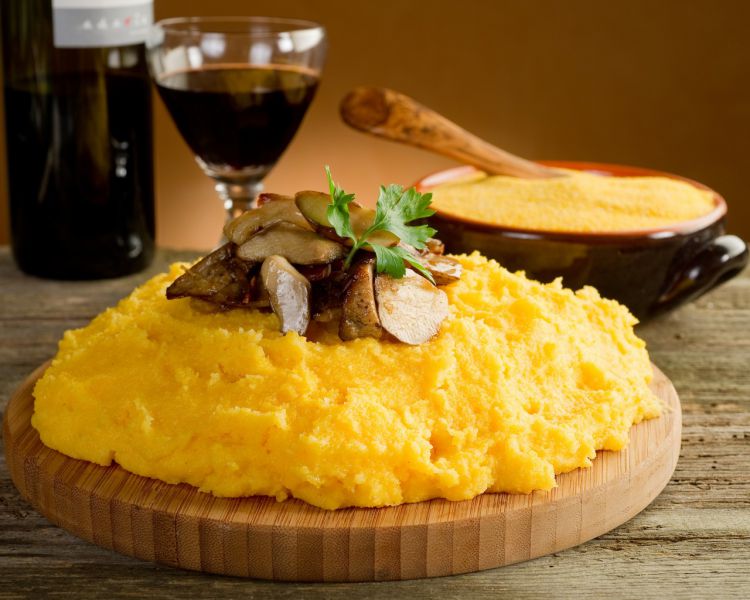 Photo source: goodfon.ru.
Photo source: goodfon.ru.
Where to taste: practically any restaurant or café in Transcarpathian region can treat its guests with Tokan.
Price: 30-50 UAH per one plate.
Mamalyha (Mămăliga)
Mamalyha is a national Moldavian course. This is a strongly mixed porridge of yellow maize flour cooked in a clay pot. What is so special in this dish? The thing is that, Mamalyha doesn’t look and taste and smell like any of porridges known. Originally it was made of millet, but when Moldavian kingdom has become rich in fields planted with corns, the main ingredient has been replaced. Besides, that time corn was not under a tax of the Turkish occupiers.
Historically, it happened so, that Mamalyha was a main meal for peasants, who used it instead of bread. To cut the course a wax thread or a wooden knife of a special kind are often used.
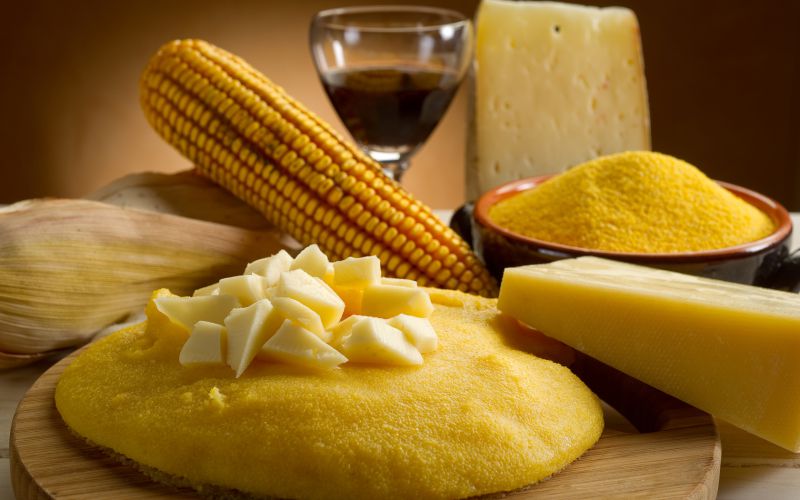 Photo source: menu.ck.ua.
Photo source: menu.ck.ua.
Where to taste: Mamalyha can be tasted at Kolyba Museum situated in Dilove, Butyn region which is considered as the geographical centre of Ukraine.
Price: the plate of 300 gr costs 35 UAH in average.
Kruchenyky
Kruchenyky or zavivantsi is a traditional Ukrainian course which can be met and tasted anywhere in Transcarpathian region. Just listen: “Khustkian kruchenyky”, “Mukachevian kruchenyky”, “Volynian kruchenyky”, each region has its own style of making this meal. Each of them has its own receipt and so the taste varies from town to town.
Kruchenyky themselves are a kind of big roll with a vegetable filling rolled tightly in a meat or fish layer. To cook this course only a few number of ingredients is needed, but nevertheless the course has a rich bouquet of flavors. You can use whatever you have to make a filling: starting from mushrooms and finishing with prunes. This starter is usually served hot, but cold kruchenyky are also very tasty.
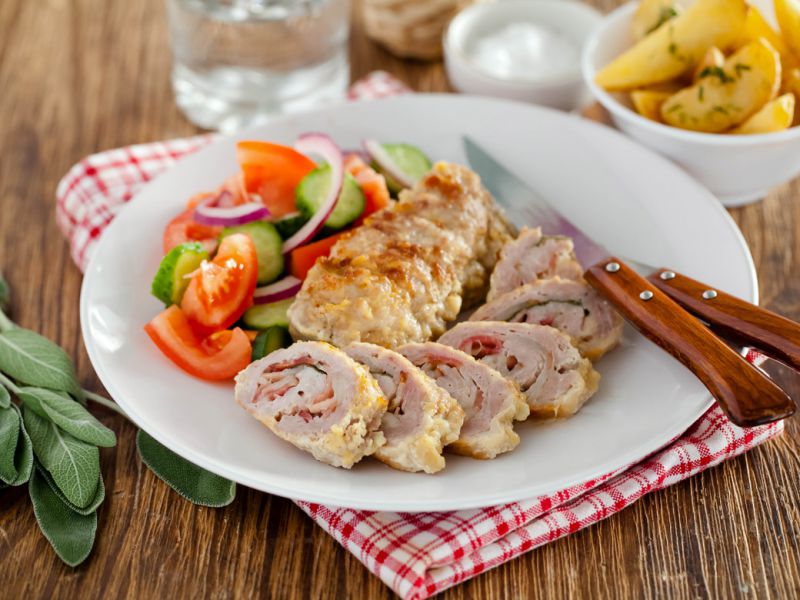 Photo source: odamochka.info.
Photo source: odamochka.info.
Where to taste: kruchenyky are cooked in lots of kolybas of Transcarpathian region. And all of them have their own secrets. While visiting this region don’t forget to taste this delicacy.
Price: 40 UAH in average.
Gombovtsy
Gombovtsy is a wonderful Hungarian course. But it is unique not for its receipt but for the fact it is almost the same course which is cooked on the other side of our planet. It means they are almost the same with Chinese steam cooked buns baozi which are so popular in Japan and South-Eastern Asia. Well, Hungarians used to be nomands, so, it makes sense to imagine this course came to us from a far away Chinese province long time ago.
Gombovtsy is nothing like buns of yeast dough in a form of sphere. They are cooked on steam with various sweet or berry fillings. The taste of this dessert depends on your imagination and filling chosen. But there is one feature in this course –after the buns are cooked they should be sprinkled with toasted breadcrumbs.
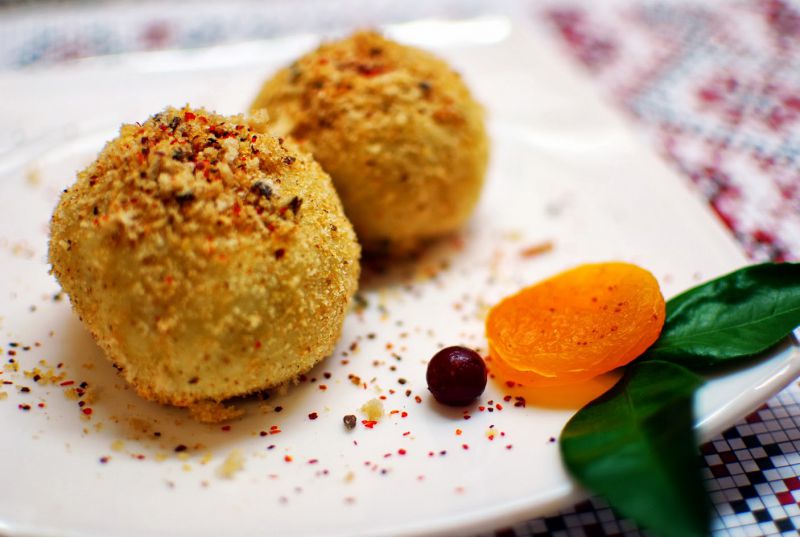 Photo source: himalayabear.blogspot.com.
Photo source: himalayabear.blogspot.com.
Where to taste: “Ungvarsky” restaurant, 29, Electrozavodska Str., Uzhgorod.
Price: Gombovtsy will cost 38 UAH to you.
Flodni and Pozsony Kifle
One more Hungarian dessert is a popular pie Flodni and bagels Pzosony Kifle. These legendary tasty pieces are cooked according to an old receipt which belongs to Hungarians of Jewish origin.
Flodni is nothing like a shortcrust pie but it has a “rich” filling inside. The main feature of this course is hidden in its filling which consists of nuts, apples and poppy, which are put in layers. In the place of its origin flodny if usually cooked for Christmas. Jewish, who borrowed this receipt, liked the pie so much, that they always serve this course for weddings. Probably, the meal is unique due to its secret ingredient – Flodni cannot be cooked without adding duck, goose or chicken lard.
 Photo source: ribchansky.com.
Photo source: ribchansky.com.
Bagels Pzosony Kifle – is one more course made by an original Hungarian receipt. Their dessert differs from any others by the fact that while cooking it both: yeast and baking powder are used. Thus, bagels appear to be crumbly and extremely tender. This is the kind of dessert which melts in your mouth.
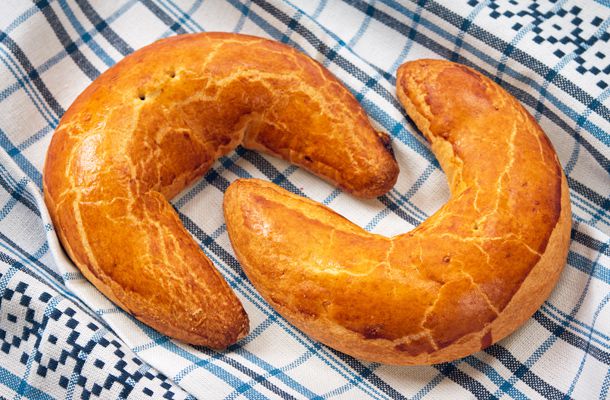 Photo source: static.femina.hu.
Photo source: static.femina.hu.
Where to taste: true Hungarian delicacies can be tasted in Beregovo. Just visit any of café or confectionary.
Price: 4 UAH in average.
Lviv coffee
The history of Lviv coffee starts from mentioning Yuriy Frants Kulchytsky – thefounder of the first coffee house in Vienna which is also one of the first ones in Europe. He was originally from Lviv. And it’s more likely, that this is how the tradition of drinking coffee came to the motherland of Mr. Kulchytsky.
Nowadays Lviv nd coffee are two essential things. While walking along narrow streets of ancient town you can’t help feeling the light tart coffee flavor coming out of small windows of numerous Lviv cafes. Lviv got totally crazy of coffee at the end of 18th century, when a huge number of cafes and confectionaries started to open on the corner of every street, and everyone could join the “ritual’ of drinking coffee. Actually Lviv never recovered from this “illnes”. It is still known as a coffee capital of Ukraine.
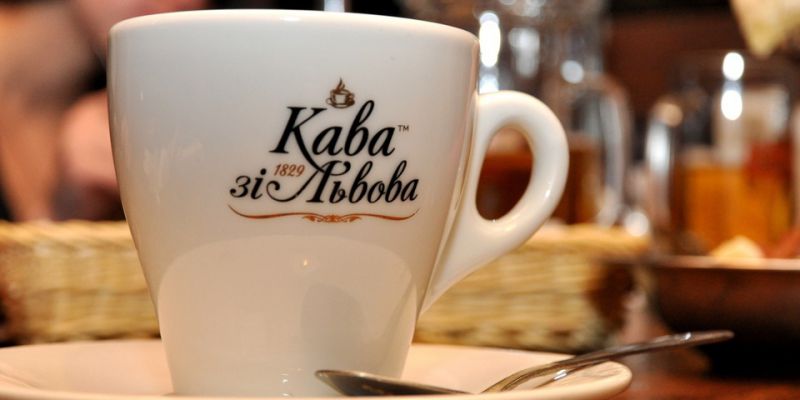 Photo source: artleo.com.
Photo source: artleo.com.
Where to taste: the best place is “Videnska Kavyarnya” situated on Svoboda avenue in Lviv. In here coffee is served along with some surprise, what really makes it worth tasting.
Price: an average price for a cup of coffee is 20 UAH.
The information about cafes and restaurants given in the article is not an advertisement and is based on our private travelling experience. The prices stated are exact for the period of the publication. We’ll be glad to see you’re sharing your experience about your culinary travels around Ukraine.








